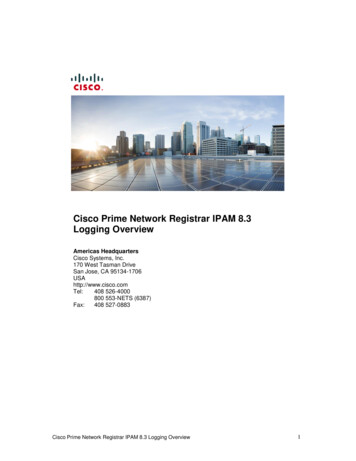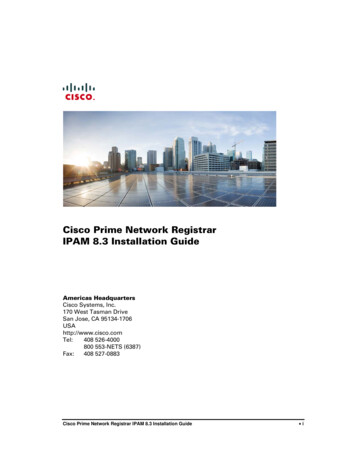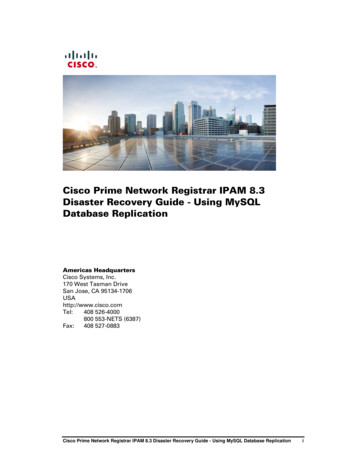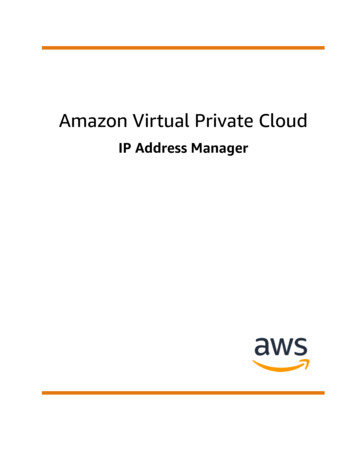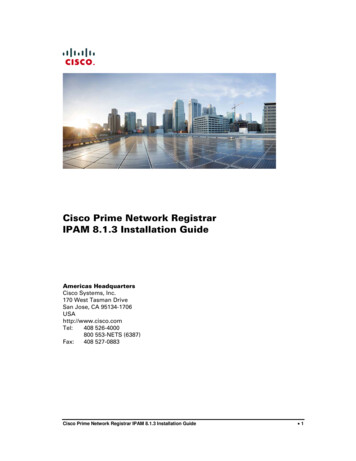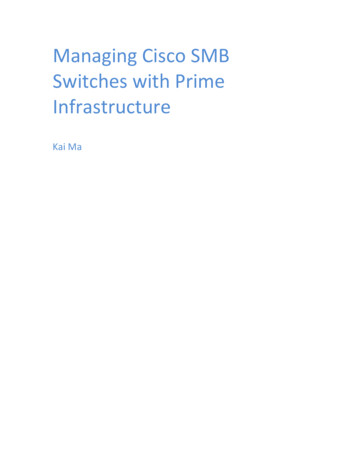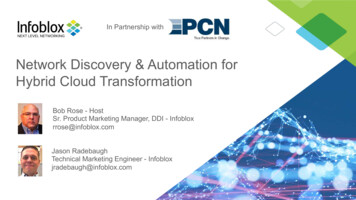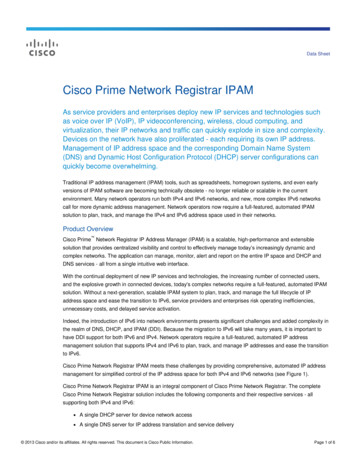
Transcription
Data SheetCisco Prime Network Registrar IPAMAs service providers and enterprises deploy new IP services and technologies suchas voice over IP (VoIP), IP videoconferencing, wireless, cloud computing, andvirtualization, their IP networks and traffic can quickly explode in size and complexity.Devices on the network have also proliferated - each requiring its own IP address.Management of IP address space and the corresponding Domain Name System(DNS) and Dynamic Host Configuration Protocol (DHCP) server configurations canquickly become overwhelming.Traditional IP address management (IPAM) tools, such as spreadsheets, homegrown systems, and even earlyversions of IPAM software are becoming technically obsolete - no longer reliable or scalable in the currentenvironment. Many network operators run both IPv4 and IPv6 networks, and new, more complex IPv6 networkscall for more dynamic address management. Network operators now require a full-featured, automated IPAMsolution to plan, track, and manage the IPv4 and IPv6 address space used in their networks.Product OverviewCisco Prime Network Registrar IP Address Manager (IPAM) is a scalable, high-performance and extensiblesolution that provides centralized visibility and control to effectively manage today’s increasingly dynamic andcomplex networks. The application can manage, monitor, alert and report on the entire IP space and DHCP andDNS services - all from a single intuitive web interface.With the continual deployment of new IP services and technologies, the increasing number of connected users,and the explosive growth in connected devices, today's complex networks require a full-featured, automated IPAMsolution. Without a next-generation, scalable IPAM system to plan, track, and manage the full lifecycle of IPaddress space and ease the transition to IPv6, service providers and enterprises risk operating inefficiencies,unnecessary costs, and delayed service activation.Indeed, the introduction of IPv6 into network environments presents significant challenges and added complexity inthe realm of DNS, DHCP, and IPAM (DDI). Because the migration to IPv6 will take many years, it is important tohave DDI support for both IPv6 and IPv4. Network operators require a full-featured, automated IP addressmanagement solution that supports IPv4 and IPv6 to plan, track, and manage IP addresses and ease the transitionto IPv6.Cisco Prime Network Registrar IPAM meets these challenges by providing comprehensive, automated IP addressmanagement for simplified control of the IP address space for both IPv4 and IPv6 networks (see Figure 1).Cisco Prime Network Registrar IPAM is an integral component of Cisco Prime Network Registrar. The completeCisco Prime Network Registrar solution includes the following components and their respective services - allsupporting both IPv4 and IPv6: A single DHCP server for device network access A single DNS server for IP address translation and service delivery 2013 Cisco and/or its affiliates. All rights reserved. This document is Cisco Public Information.Page 1 of 6
A DNS caching server that supports DNS Security Extensions (DNSSEC) and is designed to prevent cachepoisoning and other attacks A powerful, comprehensive IPAM system to automate and manage all IPv4 and IPv6 address requirementsCisco Prime Network Registrar IPAM can be deployed as a standalone application or can be integrated with theDHCP and DNS server components of Cisco Prime Network Registrar. In addition, it cohesively supports InternetSystems Consortium (ISC DHCP and BIND 9 DNS) and Microsoft DHCP and DNS services. With this multivendorsupport on existing infrastructure, IT managers no longer have to maintain multiple management consoles or dealwith complex command-line interfaces (CLIs).Figure 1.Cisco Prime Network Registrar IPv4 and IPv6 ManagementFeatures and CapabilitiesCisco Prime Network Registrar IPAM provides the following features:Manageability: Cisco Prime Network Registrar IPAM provides simplified, centralized management and control ofIP address space. Automation allows network operators to achieve significant operational efficiencies, lower IPaddress management overhead, and handle rapid IP and network expansion. IP conflicts and configuration errorsare eliminated - reducing downtime of DHCP and DNS services and lowering network operating costs. With theability to discover, track, allocate, and reclaim IP addresses automatically and tools to model IP data, organizationscan easily move away from manual systems.Consolidation of IPv4/IPv6 address management: Cisco Prime Network Registrar IPAM includes integrated, fulllifecycle management for IPv4 and IPv6. The solution helps ease the transition to IPv6 with the ability to discoverand take inventory of IPv4 and IPv6 resources, plan and model the way an IPv6 network is deployed, and map acurrent IPv4 network and devices to an IPv6 space.Visibility: Cisco Prime Network Registrar IPAM provides real-time visibility into IPv4 and IPv6 networks, subnetusage, and device connections for faster troubleshooting and promotion of collaboration across the organizationThe solution also offers detailed IP audit reporting and diagnostics as well as operator-defined thresholds andalerts that provide notification of impending address depletion. 2013 Cisco and/or its affiliates. All rights reserved. This document is Cisco Public Information.Page 2 of 6
Usability, flexibility, and control: An intuitive web-based interface promotes ease of use and boosts userproductivity. The application also offers a high level of control that allows organizations to manage their IP spaceaccording to their own policies and procedures - to bring network monitoring in line with business requirements.A patented, flexible container mechanism helps enable a user to organize IP address space according to adeployment's topology, geography, and router association for greater administrative simplicity. This flexiblecontainer model intuitively maps IP blocks to sites, customers, or departments. Well-defined administrator roles,controls, and reports promote accountability and auditability. Granular, role-based delegation of DNS and DHCPallows multiple administrators to manage the system (avoiding having to rely on a small set of IT resources).Reliability: The solution helps address unique challenges in large-scale deployments by offering redundancy withIPAM database replication for backup of data.Table 1 lists additional detailed features and benefits of Cisco Prime Network Registrar.Table 1.Features and BenefitsFeatureBenefitRapid Time to ValueIPAM ease and speed of setup IPAM accepts XLS or comma-separated value (CSV) files to import preexisting license data. Use the Import Wizard to import address space and resource records. Automated discovery facilitates creation of a central IPAM repository of network IP addresses.Rich Graphical User InterfaceIntuitive GUI A web-based interface allows administrators to quickly visualize the network and allocateaddresses based on current and future requirements. The GUI allows users to associate addressblocks easily with geography, topology, or other user-defined hierarchies through the use of acontainer model. The GUI provides administrators with a real time snapshot of the network that reduces theamount of time it takes a user to perform certain tasks, including key strokes, mouse clicks,pointing, selecting an item from a list, and more. Two-dimensional megamenus provide for easy navigation and greater visibility of availablecommand options.Context-aware menus and contextsensitive help Context-aware menus display relevant commands only for expedited operations and fasterdecision making. Context-sensitive help offers information specific to the task for greater user productivity.IP Address PlanningPlanning for hierarchical IPv4 and IPv6address space with a continualfeedback loop Planning tools facilitate development of a disciplined IPv4 and IPv6 address plan that can bedeployed, monitored, and tracked automatically - for a continuous feedback loop to assureaccuracy and provide an overall management view. Users can plan and stage the following interrelated entities for immediate or future deployment toDHCP and DNS servers: IP block or subnet allocation, IP address assignment, IPv6 prefixes andlinks, addition of a new DHCP pool and associated parameters, or DNS domain, serverconfiguration, or resource records. Discovery-to-database reconciliation and exception reporting help enable operators to view plandiscrepancies and potential errors or rogue users.Creation and management of IPv6prefixes and linksUsing IPv6 prefixes or links, operators can easily perform IPv6 address allocation, assignment,tracking, and search - for significant operational efficiencies compared to manual processes.Definition of DHCPv6 options andclient classesClient classes may be used to associate classes of devices with policies and options. For instance,you can create a VOIP client class or a cable modem client class with a policy set to provide anaddress (out of a given scope or prefix) with associated options.Creation and management of IPv4 andIPv6 client reservationsCisco Prime Network Registrar IPAM allows users to easily select and assign an IP address or prefix.User definability/flexibility andmanagement of IP address spaceEasy-to-use container architecture allows the user to define and manage topology, address space(including block allocations and subnets), device and block types, and associated attributes (throughuser-defined fields). This helps administrators to organize address space in a manner that bestmatches an organization's structure. 2013 Cisco and/or its affiliates. All rights reserved. This document is Cisco Public Information.Page 3 of 6
FeatureAddress allocation: User-definedpolicies and automationBenefit IPAM allows users to allocate space in a hierarchical, logical manner in accordance with thetopology as defined in their IP address plan. Automated allocation prevents requiring the operator to manually enter IP addresses, improvingworker productivity and network uptime, decreasing costs, and allowing service providers andenterprises to scale seamlessly. Optimal "best fit" address allocation maximizes address utilization efficiency. Customization through multiple block types provides multiple address subspaces for variousapplications or IP types such as data, VOIP, higher quality of service (QoS), and more. Simplified address renumbering allows movement of address space where it is needed.Automated and manual IP address andsubnet reclaimIPAM provides the ability to reclaim or free up IP addresses or entire subnets - a task that is crucial toassuring the IP inventory database is accurate.Address utilization trending andforecastingIPAM allows trending and forecasting of address pools, helping to prevent network access failurethrough proactive management of available addresses and utilization trends.Centralized DNS/DHCP Server ConfigurationAutomated DNS/DHCP configurationOperators can significantly reduce downtime with more accurate DNS/DHCP configurations.Advanced configuration supportSupport for DHCPv4 failover, multitiered addressing, multihomed hosts (to model multiple IPaddresses on a given device), DHCP client classes, MAC address processing, client ID, dynamicDNS, and more - all help to meet complex network operator needs.DHCP configuration verification andpreviewVerification and preview capabilities help limit network outages and IP conflicts.IP Address ManagementDiscovery Cisco Prime Network Registrar IPAM performs host discovery using a variety of methodsincluding ping, TCP port 80 connections, DNS lookups, Address Resolution Protocol (ARP) cachedata, and device OS mapping. IPAM performs integrated switch port mapping through Simple Network Management Protocol(SNMP) Bridge-MIB polling, facilitating support of a broad variety of switches, and mapping of asubnet's VLAN. Router subnet discovery identifies which IPv4 and IPv6 subnets are provisioned on given routerinterfaces. IPAM collects rich network data from a broad variety of multivendor Layer 3 routers, Layer 2switches, and DNS/DHCP servers. IPAM allows comparison of implemented network address data to the database - to highlightdiscrepancies and reconcile conflicts.User-defined thresholds and alertsUsers can set up thresholds and alerts - for example, for notification if an address space is over adesignated utilization percentile or if an address pool is forecasted to deplete within a designatedtimeframe - for proactive management. These capabilities help to facilitate planning and minimizenetwork outages and IP conflicts.Granular administrator policies andtiered administration capabilitiesGranular administrator policies within Cisco Prime Network Registrar IPAM dictate access to andvisibility and control of given functions, geographies, domains, subnets, and blocks. For serviceproviders and enterprises with multiple operations personnel responsible for different portions of thenetwork or different DHCP or DNS servers, administrators are empowered to delineate and partitionresponsibilities.Simplified Tracking and Reporting CapabilitiesHistoric reporting, tracking, andtrending Address utilization data is tracked and trended for reporting purposes. Graphical reports provide information at any level in the container or address block hierarchy tomanage IP address space capacity from both an address pool perspective and a network/subnetperspective.IPv4 and IPv6 audit reporting and alertcapabilities Audit reporting promotes accountability and provides history tracking for administrators, subnets,devices, IP addresses, and containers. Utilization tracking, analysis, and reporting, (with threshold alerting for notification of pendingaddress depletions) help preempt potential service-affecting outages and prevent: Lost productivity Calls to the help desk or customer care Lost revenue Expensive troubleshooting timeThese capabilities also assist in compliance initiatives such as: Proactive and preventative management and maintenance Inventory reporting Graphical reports 2013 Cisco and/or its affiliates. All rights reserved. This document is Cisco Public Information.Page 4 of 6
FeatureBenefitIntegration with Cisco Prime Network Registrar ComponentsIntegration with Cisco Prime NetworkRegistrar DHCP and DNS serversSeamless integration with the Cisco Prime Network Registrar components provides centralized andsimplified web-based administration to configure and control DNS and DHCP servers for both IPv4and IPv6. This eliminates the need for multiple management consoles and complicated CLIs.External Systems Integration and SupportIntegration with external systemsThe API is available for integration with third-party applications such as provisioning systems andchange management systems.Multivendor DHCP/DNS supportThe solution cohesively supports the following additional DNS and DHCP servers: Internet SystemsConsortium (ISC DHCP and BIND 9 DNS) and Microsoft, allowing support of existing infrastructure.Microsoft LDAP versions 1, 2 and 3 are supported for external authentication.System RequirementsTable 2 lists server system requirements for the Cisco Prime Network Registrar IPAM Executive CentralizedManager and the IPAM Agent.Table 2.Server System Requirements for Cisco Prime Network Registrar IPAM Executive Centralized Manager and CiscoPrime Network Registrar IPAM AgentComponentRecommendationOperating systemRed Hat Enterprise Linux 5(32-bit)Windows 2008 Server(32-bit or 64-bit Englishversions)Windows 2008 R2Server (64-bit)Memory (RAM)2 GB RAM or higherDisk space2 GB disk space for base installHardwareXeon - 1.2 GHz or faster processorCentosSolaris 10 (SPARC)Enterprise Linux 6.4(64-bit)Ordering InformationTo place an order, visit the Cisco Ordering Homepage. See the Cisco Prime Network Registrar Ordering Guide fora list of Cisco Prime Network Registrar IPAM product numbers and upgrade product numbers as well as detailedlicensing information. To download software, visit the Cisco Software Center.About Cisco PrimeThe Cisco Prime portfolio of enterprise and service provider management offerings empowers IT organizations tomore effectively manage their networks and the services they deliver. Built on a service-centered foundation, theCisco Prime portfolio of products supports integrated lifecycle management through an intuitive workflow-orienteduser experience. The portfolio of Cisco Prime solutions for service providers provides A-to-Z management for IPnext-generation networks, mobility, video, and managed services.Cisco ServicesCisco offers a wide range of services programs to accelerate customer success. Cisco services help you to protectyour network investment, optimize network operations, and prepare the network for new applications to extendnetwork intelligence and the power of your business. For more information about Cisco Services, seeCisco Technical Support Services or Cisco Advanced Services.For More InformationFor more information about Cisco Prime Network Registrar, visit http://www.cisco.com/go/networkregistrar/, contactyour local account representative, or send an email to ask-networkregistrar@cisco.com. 2013 Cisco and/or its affiliates. All rights reserved. This document is Cisco Public Information.Page 5 of 6
Printed in USA 2013 Cisco and/or its affiliates. All rights reserved. This document is Cisco Public Information.C78-729478-0109/13Page 6 of 6
Traditional IP address management (IPAM) tools, such as spreadsheets, homegrown systems, and even early versions of IPAM software are becoming technically obsolete - no longer reliable or scalable in the current environment. Many network operators run both IPv4 and IPv6 networks, and new, more complex IPv6 networks
